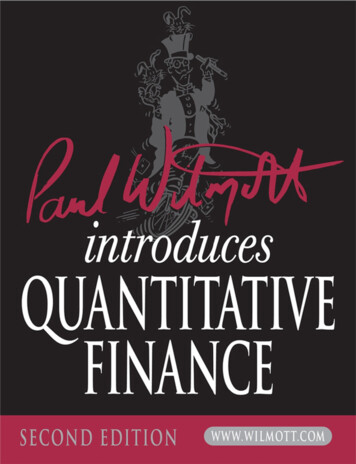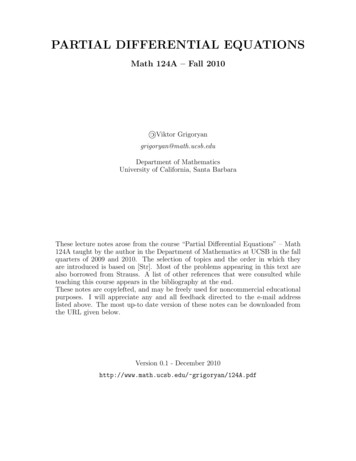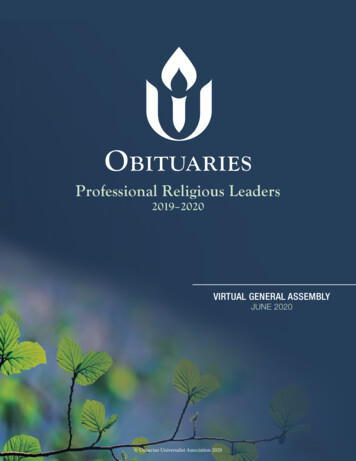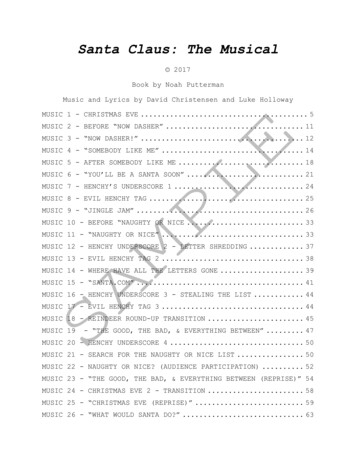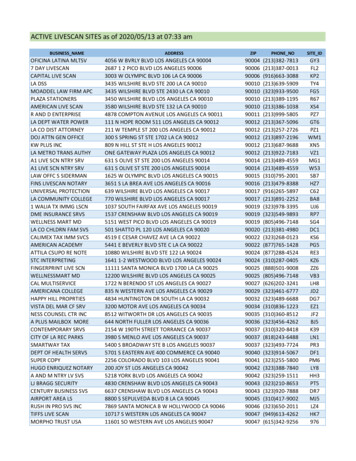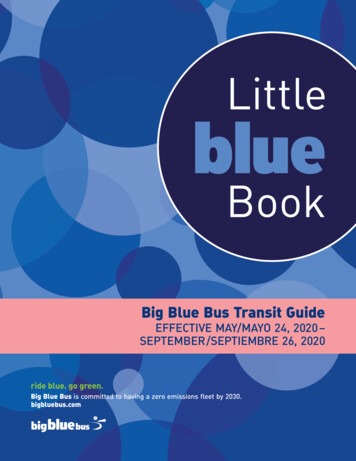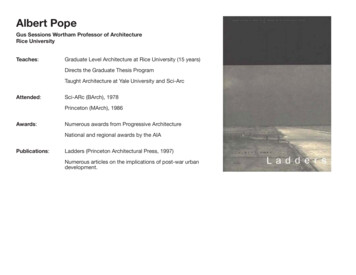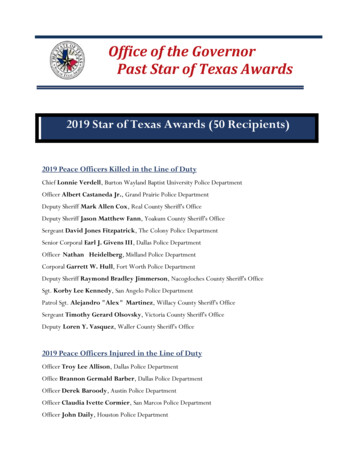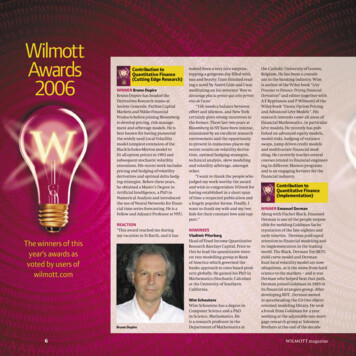
Transcription
WilmottAwards2006Contribution toQuantitative Finance(Cutting Edge Research)WINNER Bruno DupireBruno Dupire has headed theDerivatives Research teams atSociete Generale, Paribas CapitalMarkets and Nikko FinancialProducts before joining Bloombergto develop pricing, risk management and arbitrage models. He isbest known for having pioneeredthe widely used Local Volatilitymodel (simplest extension of theBlack-Scholes-Merton model tofit all option prices) in 1993 andsubsequent stochastic volatilityextensions. His recent work includespricing and hedging of volatilityderivatives and optimal delta hedging strategies. Before these years,he obtained a Master’s Degree inArtificial Intelligence, a PhD inNumerical Analysis and introducedthe use of Neural Networks for financial time series forecasting. He is aFellow and Adjunct Professor at NYU.REACTION“This award reached me duringmy vacation in St Barth, and it hasThe winners of thisyear’s awards asvoted by users ofwilmott.comBruno Dupire6indeed been a very nice surprise,topping a gorgeous day filled withsun and beauty. I just finished reading a novel by André Gide and I wasmeditating on his sentence ’Rien nedécourage plus la pensée que cette persistence de l’azur.’“Life needs a balance betweeneffort and idleness, and New Yorkcertainly gives strong incentives tothe former. These last two years atBloomberg in NY have been intense,stimulated by an excellent researchenvironment and the opportunityto present in numerous places myrecent results on volatility derivatives, optimal hedging strategies,technical analysis, skew modelingand volatility arbitrage, amongstother.“I want to thank the people whojudged my work worthy the awardand wish to congratulate Wilmott forhaving established in a short spanof time a respected publication anda hugely popular forum. Finally, Iwant to thank my wife and my twokids for their constant love and support.”NOMINEESVladimir PiterbargHead of Fixed Income QuantitativeResearch Barclays Capital. Prior tothis he lead the quantitative interest rate modelling group at Bankof America which governed thebanks approach to rates based products globally. He gained his PhD inMathematics (Stochastic Calculus)at the University of SouthernCalifornia.Wim SchoutensWim Schoutens has a degree inComputer Science and a PhDin Science, Mathematics. Heis a research professor in theDepartment of Mathematics atthe Catholic University of Leuven,Belgium. He has been a consultant to the banking industry. Wimis author of the Wiley book “LévyProcesses in Finance: Pricing FinancialDerivatives” and editor (together withA E Kyprianou and P Wilmott) of theWiley-book “Exotic Option Pricingand Advanced Lévy Models”. Hisresearch interests cover all areas offinancial Mathematics, in particularLévy models. He recently has published on advanced equity models,model risks, hedging of varianceswaps, jump driven credit modelsand multivariate financial modeling. He currently teaches severalcourses related to financial engineering in different Masters programsand is an engaging lecturer for thefinancial industry.Contribution toQuantitative Finance(Implementation)WINNER Emanuel DermanAlong with Fischer Black, EmanuelDerman is one of the people responsible for molding Goldman Sachs’reputation of the late eighties andearly nineties. Derman paid equalattention to financial modeling andits implementation in the tradingworld. The Black, Derman Toy (BDT)yield curve model and DermanKani local volatility model are nowubiquitous, as is the move from hardscience to the markets – and it wasDerman who helped beat that path.Derman joined Goldman in 1985 inits financial strategies group. Afterdeveloping BDT , Derman movedto spearheading the GS-One objectoriented modeling library. He tooka break from Goldman for a yearworking at the adjustable rate mortgage research group at SalomonBrothers at the end of the decadeWilmott magazine
2006 WILMOTT AWARDSsurvive.“The mix of disciplines thatmakes the field so stimulating waseasier to achieve when I started outin this business and everything wasless specialized. I still like mixtures– combining pie-in-the-sky theorywith the indignities of reality, working alone and then interacting withpeople. I suppose mixtures are partof the reason I like derivatives too.So, I’m particularly pleased to bethe recipient in the QuantitativeFinance (implementation) category. Ithank Wilmott and its readers for thishonor.Emanuel Dermanbefore returning to Goldman Sachsin 1990 as head of its equities division’s quantitative strategies group.Derman devoted the next ten yearsto developing models of volatilitybehavior, exotic options pricing andvariance swaps, as well as buildingtrading software for Goldman’sequity derivatives division. Dermanmoved to firmwide risk in early 2000as head of its derivatives analysisgroup, where he ran Goldman’squantitative risk strategies group in2001 His hallmark has always beenan ability to bring the best aspects ofan academic approach to heel in thereal world, as described in his recentbook My Life as a Quant: Reflections onPhysics and Finance.REACTION“I was very gratified to be the recipient of the Wilmott Award. I learnedfrom experience to regard quantitative finance as a multi-disciplinaryfield, a mix of financial theory,mathematics and computer science,overlaid with a skeptical attitudeand an ability to talk to and learnfrom the people who use this stuff toWilmott magazineNOMINEESBruno DupirePeter JaeckelDr. Peter Jaeckel is the Global Headof Credit, Hybrid, Commodityand Inflation Derivatives, ABNAMRO. He received his DPhil fromOxford University in 1995. Jaeckelhas worked with CommerzbankSecurities in London in the frontoffice product development andderivatives modeling group. Prior tothat he worked within the NatWestGroup/Royal Bank of ScotlandQuantitative Research Centre. Hestarted his career in finance withNikko Securities’ London operation in 1997. His book Monte CarloMethods in Finance has become aninvaluable resource for quantitativeanalysts who need to run modelsthat assist in option pricing and riskmanagement. This concise, practical hands-on guide to Monte Carlosimulation introduces standard andadvanced methods to the increasingcomplexity of derivatives portfolios.Ranging from pricing more complexderivatives, such as American andAsian options, to measuring Value atRisk, or modeling complex marketdynamics, Jaeckel has shown thatsimulation is the only method general enough to capture the complexityand Monte Carlo simulation is thebest pricing and risk managementmethod available.TechnologicalDevelopmentoptimal hedging in incomplete markets replaces the Black-Scholes delta.“However the best is yet to come aswe will soon unveil the ultimate toolthat encapsulates all these radicaladvances”NOMINEESXenomorphUnRiskWINNER ITO 33SoftwareREACTIONElie Ayache, founder, ITO 33“Some people call our products difficult and esoteric. Indeed modernderivative pricing is a very hardproblem that is crying out for a radical revision of the technology, evenfor a philosophical critique to try toestablish what we expect from thetechnology in the first place.“It is hard to replace Black-Scholesnot only because this historic modelis so widely used but because thehardest part is to first understandhow Black-Scholes can be so simple.“The primary task should be tountangle the strands that make upBlack-Scholes: implied volatilityand dynamic hedging, and see howthey can be preserved and generalized in a world that is obviously notBlack-Scholes. That my company haswon this year’s Wilmott Award forTechnological Development is proofthat our philosophy and its application to derivative technology is nowmeeting with public recognition.“Our advanced numerical schemesreplace the speed and robustness ofthe analytical Black-Scholes formula.Our solution for calibration and recalibration replaces implied volatility, and our algorithm for dynamicWINNER lEducatorWINNER Nassim Nicholas TalebNNT is the Dean’s Professor inthe Sciences of Uncertainty at theUniversity of Massachusetts atAmherst. He is also an essayist, belletrist, literary-philosophical-mathematical flâneur, and practitionerof uncertainty (“mathematicaltrader”) focusing on the attributesof unexpected events, with a focuson extreme deviations, the “BlackSwans” (i.e. outliers), their unpredictability, and our general inabilityto forecast.NNT is only interested in onesingle topic, chance (particularlyextreme & rare events); but it fallsat the intersection of philosophy/epistemology (skepticism; knowledge about the dynamics of history;inferential claims), philosophy/ethics (stoicism facing random events;theories of nonhedonic happiness),7
2006 WILMOTT AWARDSmathematics (probability, statistical physics), social science/finance(opacity & incomplete information;why economists have no clue butthink that they know a lot), and cognitive science (how we are “fooled”by randomness). He mainly deriveshis intuitions from a 2-decade longand intense practice of derivativestrading (“nondull” activities withplenty of randomness). The ideas areexpressed in literary form in the trilogy: Fooled by Randomness (2001, 2004,17 languages, confusion of luck andskills), The Black Swan (2006, epistemology/philosophy of history, history explained by large deviations),and Chance and the Logic of Happiness(c. 2007, ethics/ stoicism, nonhedonic happiness).REACTION“This is an honor for me particularly that I give a small number oflectures. I lecture just as I write,from my guts not my brain, withno regards for formalism and withcontempt for anything remotely academic. I never thought that it wouldever be recognized. Thank you forputting up with me and giving methis award.”Nassim Nicholas Taleb10NOMINEESMike StauntonMike has been demystifying thearcane of spreadsheet modelling forboth academics and practitionersfor two decades – and over that timehas become rather good at it! He isthe author (with Mary Jackson) ofthe blockbuster Advanced Modelling inFinance using Excel and VBA “the bookwith no exercises and lots of practical code that works”. His regularcolumn in Wilmott magazine continues this service to the communitywith concision and applicabilitythat are Mike’s hallmarks. Mike isbased at the London Business Schoolwhere he is a director of the LondonShare Price Database. Mike is visiting lecturer in Numerical Methodsat Cass Business School in London,where he teaches on the Masters inMathematical Trading and FinanceBill ZiembaBill is the Alumni Professor ofFinancial Modeling and StochasticOptimization, Emeritus in theSauder School of Business, Universityof British Columbia where he taughtfrom 1968 to 2004. He now teaches asa visiting professor. His experience isregularly imparted to the readers ofWilmott through his regular columnwhich provides insight into aspectsof scenario management both historical and current and an alwaysengaging insight into his research inasset-liability management, portfoliotheory and practice, security marketimperfections, Japanese and Asianfinancial markets, sports and lotteryinvestments and applied stochasticprogramming Bill is series editorfor North Holland’s Handbooks inFinance series and is author or editor of a continuing stream of influential books in various areas of investments and financial markets, and is afrequent speaker at conferences andseminars around the world.New Book of the Year(General Finance)WINNER FreakonomicsSteven D Levitt, Stephen J DubnerAllen Lane – Penguin (2005)Which is more dangerous, a gun ora swimming pool? What do schoolteachers and sumo wrestlers have incommon? Why do drug dealers stilllive with their moms? How much doparents really matter? What kindof impact did Roe v. Wade have onviolent crime?Through forceful storytellingand wry insight, Levitt and co-authorStephen J. Dubner show that economics is, at root, the study of incentives- how people get what they want, orneed, especially when other peoplewant or need the same thing. InFreakonomics, they set out to explorethe hidden side of É well, everything.The inner workings of a crack gang.The truth about real-estate agents. Themyths of campaign finance. The telltale marks of a cheating schoolteacher. The secrets of the Ku Klux Klan.Freakonomics establishes thisunconventional premise: if morality represents how we would likethe world to work, then economicsrepresents how it actually does work.It is true that readers ofthis book will be armedwith enough riddles andstories to last a thousandcocktail parties. ButFreakonomics can providemore than that. It will literally redefine the way weview the modern world.NOMINEESFortune’s Formula: TheUntold Story of the Scientific BettingSystem That Beat the Casinos andWall StreetWilliam PoundstoneFarrar, Strass & Giroux – Hill & Wang(2005)In 1956 two Bell Labs scientists discovered the scientific formula forgetting rich. One was mathematician Claude Shannon, neuroticfather of our digital age, whose genius is ranked with Einstein’s. Theother was John L. Kelly, Jr., a Texasborn, gun-toting physicist. Togetherthey applied the science of information theory –the basis of computersand the Internet – to the problem ofmaking as much money as possible,as fast as possible.Shannon and MIT mathematicianEdward O Thorp took the “Kelly formula” to the roulette and blackjacktables of Las Vegas. It worked. Theyrealized that there was even moremoney to be made in the stock market, specifically in the risky tradingknown as arbitrage. Thorp used theKelly system with his phenomenallysuccessful hedge fund PrincetonNewport Partners. Shannon becamea successful investor, too, toppingeven Warren Buffett’s rate of returnand using his wealth to drop outof the scientific world. Fortune’sFormula traces how the Kelly formulasparked controversy even as it madefortunes at racetracks, casinos, andtrading desks. It revealsthe dark side of thisalluring scheme, whichis founded on exploitingan insider’s edge. Thecast of character spans J.Edgar Hoover, RudolphGiuliani, Michael Milkenand Warren Buffett;Hollywood producers,Wall Street crooks, snarkyNobel Laureates, andWilmott magazine
2006 WILMOTT AWARDSthe Jewish mob. Fortune’s Formulaexplores a new and surprising side tothe Shannon legacy. Based in part onShannon’s previously unseen personal records as well as interviews withboth of Shannon’s wives, Thorp, andmany others, it is the first full-lengthtreatment of a subject that is changing ideas about finance. ClaudeShannon believed it was possible fora smart investor to beat the market– and Fortune’s Formula will convinceyou he was right.Busting Vegas: The MIT Whiz KidWho Brought the Casinos to TheirKneesBen MezrichWilliam Morrow – HarperCollins(2005)Semyon Dukach was known as theDarling of Las Vegas. A legend at agetwenty-one, this cocky hotshot wasthe biggest high roller to appear inSin City in decades, a mathematicalgenius with a system the casinoshad never seen before and couldn’tstop – a system that has never beenrevealed until now; that has nothing to do with card counting, wasn’tillegal, and was more powerful thananything that had been tried before.Las Vegas. Atlantic City. Aruba.Barcelona. London. And the jewel ofthe gambling crown – Monte Carlo.Dukach and his fellow MITstudents hit them all and mademillions. They came in hard, withstacks of cash; big, seemingly insanebets; women hanging on their arms;and fake identities. Although theywere taking classes and studyingfor exams during the week, overthe weekends they stormed theblackjack tables only to be harassed,banned from casinos, threatenedat gunpoint, and beaten in Vegas’snotorious back rooms.In the classroom, they wereWilmott magazinegeeks. On the casino floor, they wereunstoppable.Busting Vegas is Dukach’s unbelievably true story; a rivetingaccount of monumental greed,excess, hubris, sex, love, violence,fear, and statistics that is high-stakesentertainment at its best.Fischer Black and the RevolutionaryIdea of FinancePerry MehrlingWiley (2005)Fischer Black and the Revolutionary Ideaof Finance explores Fischer Black’sintellectual journey from Harvardto the offices of ADL, from theUniversity of Chicago to MIT, andthen to Goldman Sachs. Years ofresearch and interviews with Black’sbusiness and academic associates,as well as family and friends, aredistilled into a scholarly yet personalstory of the formation and development of the extraordinary mind andunique character of this unassuming renegade. This poignant booktells the story of one man’s intellectual adventure at the very center ofmodern finance. It is a story aboutthe birth of quantitative finance andfinancial engineering. It is also thestory about the continuing humanquest to defeat the “dark forcesof time and ignorance,” as JohnMaynard Keynes famously put it.New Book of the Year(Quantitative Finance)WINNER Inside Volatility Arbitrage:The Secrets of SkewnessAlireza JavaheriWiley (2005)Today’s traders want to know whenvolatility is a sign that the sky is falling (and they should stay out of themarket), and when it is a sign of apossible trading opportunity. InsideVolatility Arbitrage can help them dothis. Author and financial expertAlireza Javaheri uses the classicapproach to evaluating volatility– time series and financial econometrics – in a way that he believes issuperior to methods presently usedby market participants. He also suggests that there may be “skewness”trading opportunities that can beused to trade the markets more profitably. Filled with in-depth insightand expert advice, Inside VolatilityArbitrage will help traders discoverwhen “skewness” may present valuable trading opportunities as well aswhy it can be so profitable.NOMINEESFinance and Derivatives:Theory & PracticeSebastien Bossu andPhilippe HenrotteWiley (2005)Finance & Derivatives: Theory & Practice- by Bossu & Henrotte is a translationof the successful French languagebook Exercises de Finance desMarches, published by Dunod. It contains a selection of exercises, alongwith the relevant financial theory,that can be used by advanced undergraduate and postgraduate students.As well as being ideal for adoptionon university courses, it will also behighly valuable as a self-study guidefor practitioners.Asset Price Dynamics,Volatility, and PredictionStephen J. TaylorPrinceton University Press(2005)Stephen Taylor providesa comprehensive introduction to the dynamicbehavior of asset prices,relying on finance theoryand statistical evidence. He usesstochastic processes to define mathematical models for price dynamics,but with less mathematics thanin alternative texts. The key topicscovered include random walk tests,trading rules, ARCH models, stochastic volatility models, high-frequencydatasets, and the information thatoption prices imply about volatilityand distributions.Asset Price Dynamics, Volatility, andPrediction is ideal for students of economics, finance, and mathematicswho are studying financial econometrics, and will enable researchersto identify and apply appropriatemodels and methods. It will likewisebe a valuable resource for quantitative analysts, fund managers, riskmanagers, and investors who seekrealistic expectations about futureasset prices and the risks to whichthey are exposed.Quantitative Finance for Physicists Anatoly B SchmidtElsevier (2005)With more and more physicists andphysics students exploring the possibility of utilizing their advancedmath skills for a career in the financeindustry, this much-needed bookquickly introduces them to fundamental and advanced finance principles and methods. Quantitative Financefor Physicists provides a short, straightforward introduction forthose who already havea background in physics.Find out how fractals,scaling, chaos, and otherphysics concepts are useful in analyzing financial time series. Learnabout key topics in quantitative finance such asoption pricing, portfoliomanagement, and risk11W
WILMOTT AWARDS 2006measurement. This book providesthe basic knowledge in financerequired to enable readers with physics backgrounds to move successfullyinto the financial industry.40Wilmott magazine
quantitative risk strategies group in 2001 His hallmark has always been an ability to bring the best aspects of an academic approach to heel in the real world, as described in his recent book My Life as a Quant: Reflections on Physics and Finance. REACTION “I was very gratified to be the re

